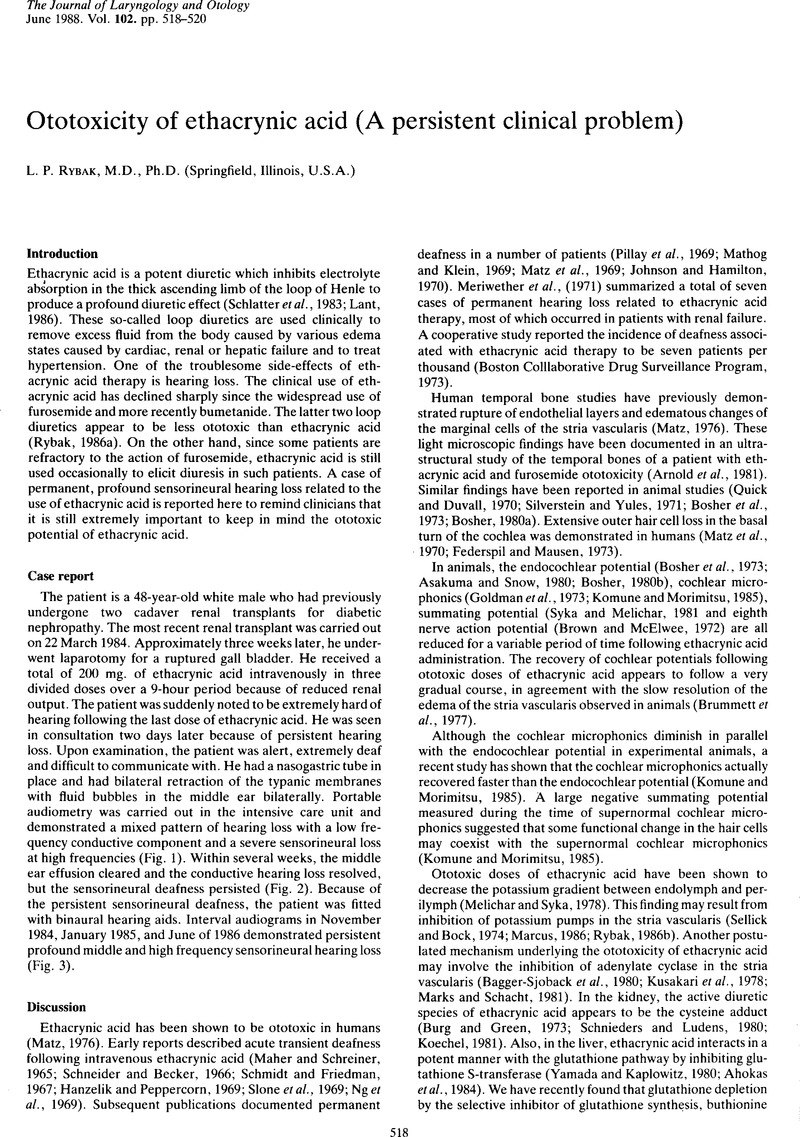Crossref Citations
This article has been cited by the following publications. This list is generated based on data provided by Crossref.
Rybak, L.P.
and
Whitworth, C.
1988.
Quinine reduces noxious cochlear effects of furosemide and ethacrynic acid.
American Journal of Otolaryngology,
Vol. 9,
Issue. 5,
p.
238.
Huang, May Y.
and
Schacht, Jochen
1989.
Drug-Induced Ototoxicity.
Medical Toxicology and Adverse Drug Experience,
Vol. 4,
Issue. 6,
p.
452.
Rybak, L.P.
Whitworth, C.
and
Scott, V.
1990.
Organic acids do not alter the cochlear effects of ethacrynic acid.
Hearing Research,
Vol. 46,
Issue. 1-2,
p.
95.
Luchi, Robert J.
Taffet, George E.
and
Teasdale, Thomas A.
1991.
Congestive Heart Failure in the Elderly.
Journal of the American Geriatrics Society,
Vol. 39,
Issue. 8,
p.
810.
Xu, Shihua
Roychowdhury, Sukla
Gaskin, Felicia
and
Epstein, David L.
1992.
Ethacrynic acid inhibition of microtubule assembly in Vitro.
Archives of Biochemistry and Biophysics,
Vol. 296,
Issue. 2,
p.
462.
Rybak, Leonard P.
1993.
Ototoxicity of Loop Diuretics.
Otolaryngologic Clinics of North America,
Vol. 26,
Issue. 5,
p.
829.
von Bruchhausen, F.
Ebel, S.
Hackenthal, E.
Dannhardt, G.
Frahm, A. W.
Holzgrabe, U.
Keller, K.
Nürnberg, E.
Rimpler, H.
Schneider, G.
Surmann, P.
Wolf, H. U.
and
Wurm, G.
1993.
Hagers Handbuch der Pharmazeutischen Praxis.
p.
1.
SCOTT, P. M. J.
and
GRIFFITHS, M. V.
1994.
A CLINICAL REVIEW OF OTOTOXICITY.
Clinical Otolaryngology,
Vol. 19,
Issue. 1,
p.
3.
Rasgado‐Flores, Hector
Peña‐Rasgado, Cecilia
and
Ehrenpreis, Seymour
1995.
Cell volume and drug action: Some interactions and perspectives.
Drug Development Research,
Vol. 36,
Issue. 2,
p.
61.
Garetz, Susan L.
and
Schacht, Jochen
1996.
Clinical Aspects of Hearing.
Vol. 7,
Issue. ,
p.
116.
Bellman, S.C.
1996.
Monitoring chemotherapy-induced hearing loss in children.
European Journal of Cancer,
Vol. 32,
Issue. 7,
p.
1185.
McFadden, Sandra L
Ding, Dalian
Jiang, Haiyan
Woo, Jenifer M
and
Salvi, Richard J
2002.
Chinchilla models of selective cochlear hair cell loss.
Hearing Research,
Vol. 174,
Issue. 1-2,
p.
230.
Ding, Dalian
McFadden, Sandra L
Woo, Jenifer M
and
Salvi, Richard J
2002.
Ethacrynic acid rapidly and selectively abolishes blood flow in vessels supplying the lateral wall of the cochlea.
Hearing Research,
Vol. 173,
Issue. 1-2,
p.
1.
Ding, Dalian
McFadden, Sandra L.
Browne, Richard W.
and
Salvi, Richard J.
2003.
Late dosing with ethacrynic acid can reduce gentamicin concentration in perilymph and protect cochlear hair cells.
Hearing Research,
Vol. 185,
Issue. 1-2,
p.
90.
Forge, Andrew
Taylor, Ruth
and
Harpur, Ernest S.
2009.
General, Applied and Systems Toxicology.
Rybak, Leonard P.
2010.
Cummings Otolaryngology - Head and Neck Surgery.
p.
2169.
Forge, Andrew
Taylor, Ruth
and
Bolon, Brad
2011.
Fundamental Neuropathology for Pathologists and Toxicologists.
p.
413.
Han, Dandan
Tang, Baokun
and
Row, Kyung Ho
2013.
DETERMINATION OF DIURETIC DRUGS IN HUMAN URINE USING DISPERSIVE LIQUID–LIQUID MICROEXTRACTION BY HIGH PERFORMANCE LIQUID CHROMATOGRAPHY.
Journal of Liquid Chromatography & Related Technologies,
Vol. 36,
Issue. 15,
p.
2069.
Houston, Brian A.
Kalathiya, Rohan J.
Kim, Daniel A.
and
Zakaria, Sammy
2015.
Volume Overload in Heart Failure.
Mayo Clinic Proceedings,
Vol. 90,
Issue. 9,
p.
1247.
Garinis, Angela C.
Kemph, Alison
Tharpe, Anne Marie
Weitkamp, Joern-Hendrik
McEvoy, Cynthia
and
Steyger, Peter S.
2018.
Monitoring neonates for ototoxicity.
International Journal of Audiology,
Vol. 57,
Issue. sup4,
p.
S54.



